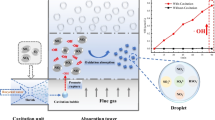Abstract
In this work, the removal of dilute nitrogen oxides NOx from the gaseous effluents of Tunisian nitric acid plant by absorption into aqueous hydrogen peroxide solutions containing or not nitric acid was studied. All semi-continuous absorption tests were carried out at ambient conditions and at 40 Pa as NOx partial pressure. The effects of the gas flow rate, the initial H2O2 concentration and the presence of HNO3 on the NOx absorption efficiency (ANOx) were studied. The tests results revealed that ANOx increases with an increase in initial H2O2 concentration in the scrubbing liquid, but decreases with an increase of gas flow rate. Furthermore, the presence of nitric acid in the aqueous hydrogen peroxide solution has a positive effect on ANOx. These results confirmed that the removal of NOx liberated from the plants of the Tunisian Chemical Group (TCG) by absorption into H2O2 solution is a feasible and an effective solution.













Similar content being viewed by others
References
EFMA (2000) Production of nitric acid, in: best available techniques for pollution prevention and control in the european fertilizer industry, European Fertilizer Manufacturers’ Association, Brussels
Yildirim O, Kiss AA, Huser N, Lebmann K, Kenig E (2012) Reactive absorption in chemical process industry: a review on current activities. Chem Eng J 213:371–391
Thiemann M, Scheibler E, Wiegand KW (2012) Nitric acid, nitrous acid, and nitrogen oxides. Ullmann’s Encycl Ind Chem 24:178–225
Wiegand KW, Scheibler E, Thiemann M (1990) Computation of plate columns for NOx absorption by a new stage to stage method. Chem Eng Technol 13:289–297
Dvorak R, Chlapek P, Jecha D, Puch R, Stehlık P (2010) New approach to common removal of dioxins and NOx as a contribution to environmental protection. J Clean Prod 18(9):881–888
Liang Z, Ma X, Lin H, Tang Y (2011) The energy consumption and environmental impacts of SCR technology in China. Appl Energy 88(4):1120–1129
Chen CT, Tan WL (2012) Mathematical modeling, optimal design and control of an SCR reactor for NOx removal. J Taiwan Inst Chem Engin 43(3):409–419
ANPE: Agence Nationale de Protection Environnementale (2010). Décret N° 2010–2519 fixant les valeurs limites à la source des polluants de l’air de sources fixes
Chung SJ, Moon IS (2013) An improved method of removal for high concentrations of NO by electro-scrubbing process. Process Saf Environ Prot 91(1–2):153–158
Pillai KC, Chung SJ, Raju T, Moon IS (2009) Exprimental aspects of combined NOx and SO2 removal from flue gas mixture in an integrated wet scrubber electrochemical cell system. Chemodphere 76(5):657–664. https://doi.org/10.1016/j.chemosphere.2009.04.013
Zhao Y, GUO TX, Chen ZY, Du YR (2010) Simultaneous removal of SO2 and NO using M/NaClO2 complex absorbent. Chem Eng J 160:42–47
Khan NE, Andewuji YG (2010) Absorption and oxidation of nitric oxide (NO) by aqueous solutions of sodium persulfate in bubble column reactor. Ind Eng Chem Res 49:8749–8760
Patwardhan JA, Joshi JB (2003) Unified model for NOx absorption in aqueous alkaline and dilute acidic solutions. AICHE J 49(11):2728–2748
De Paiva JL, Kachan GC (1998) Modeling and simulation of a packed column for NOx absorption with hydrogen peroxide. Ind Eng Chem Res 37(2):609–614
Liémans I, Thomas D (2013) Simultaneous NOx and SOx reduction from oxyfuel exhaust gases using acidic solutions containing hydrogen peroxide. Energy Procedia 37:1348–1356
Myers EB Jr, Overcamp TJ (2002) Hydrogen peroxide scrubber for the control of nitrogen oxides. Environ Eng Sci 19(5):321–327
Chu H, Chien TW, Twu BW (2001) The absorption of NO in NaClO2/NaOH solutions. J Hazard Mater 84(2–3):241–252
De Paiva JL, Kachan GC (2004) Absorption of nitrogen oxides in aqueous solution in a structured packing pilot column. Chem Eng Process 43(7):941–948
Thomas D, Vanderschuren J (1996) The absorption oxidation of NOx with hydrogen peroxide for the treatment of tail gases. Chem Eng Sci 51(11):2649–2654
Thomas D, Vanderschuren J (1998) Effect of temperature on NOx absorption into nitric acid solutions containing hydrogen peroxide. Ind. Eng. Res 37(11):4418–4423
Hüpen B, Kenig EY (2005) Rigorous modelling of NOx absorption in tray and packed columns. Chem Eng Sci 60(18):6462–6471
Dalaouti N, Seferlis P (2005) Design sensitivity of reactive absorption units for improved dynamic performance and cleaner production: the NOx removal process. J Clean Prod 13(15):1461–1470
Lee YN, Lind JA (1986) Kinetics of aqueous phase oxidation of nitrogen by hydrogen peroxide. J Geophys Res 91:2793–2800
Baveja KK, Subbarao D, Sarkar SK (1979) Kinetics of absorption of nitric oxide in hydrogen peroxide solutions. J Chem Eng Jpn 12(4):322–325
Liémans I, Alban B, Tranier JP, Thomas D (2011) SOx and NOx absorption based removal into acidic conditions for the flue gas treatment in oxy-fuel combustion. Energy Procedia 4:2847–2854
Baveja KK, Subbarao D, Sarkar SK (1979) Kinetics of absorption of nitric oxide in hydrogen peroxide solutions. J Chem Eng Jpn 12:322–325
Rodier, J. (2016). L’analyse de l’eau - Eaux naturelles, eaux résiduaires, eau de mer. 10e édition. Dunod, Paris
Barrut B (2011) Etude et optimisation du fonctionnement d’une colonne airlift à dépression–Application à l’aquaculture, Université Montpellier II
Thomas D, Vanderschuren J (2000) Analysis and prediction of the liquid phase composition for the absorption of nitrogen oxides into aqueus solutions. Sep Purif Techn 18:37–45
Suchak NJ, Joshi JB (1994) Simulation and optimization of NOx absorption system in nitric acid manufacture. AICHE J 40:944–956
Acknowledgements
We would like to thank all the workers and staff in the Tunisian Chemical Group (TCG) and those in the National Engineering school of Gabes (ENIG).
Author information
Authors and Affiliations
Corresponding author
Additional information
Publisher's Note
Springer Nature remains neutral with regard to jurisdictional claims in published maps and institutional affiliations.
Rights and permissions
About this article
Cite this article
Ghriss, O., Ben Amor, H., Chekir, H. et al. NOx scrubbing with H2O2/HNO3 solutions achieved with a laboratory bubble contactor. J Mater Cycles Waste Manag 22, 56–64 (2020). https://doi.org/10.1007/s10163-019-00912-7
Received:
Accepted:
Published:
Issue Date:
DOI: https://doi.org/10.1007/s10163-019-00912-7




